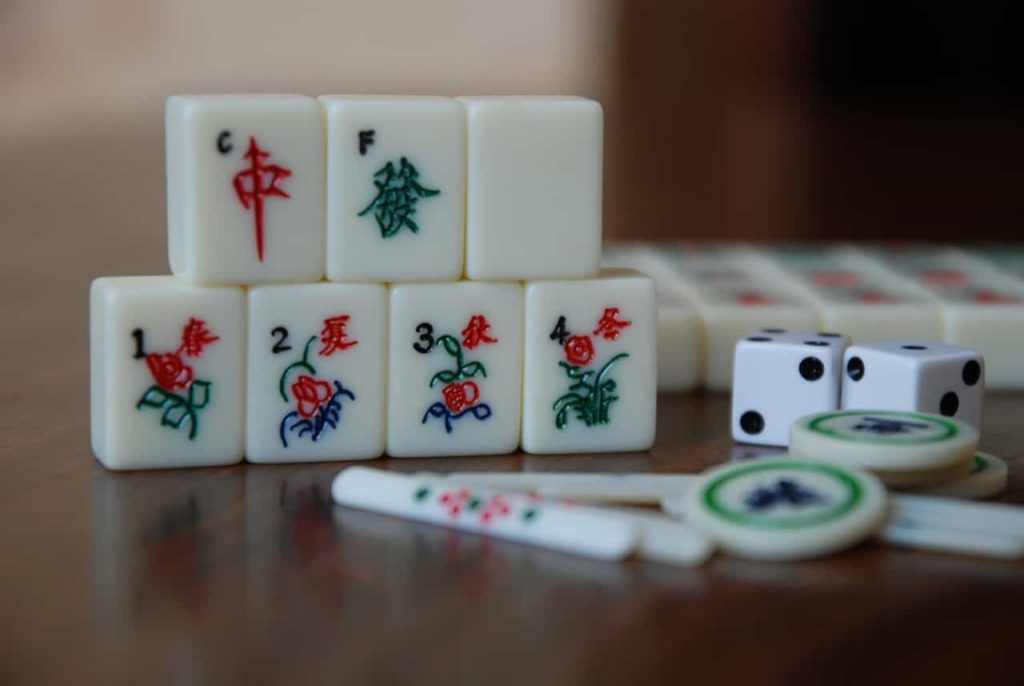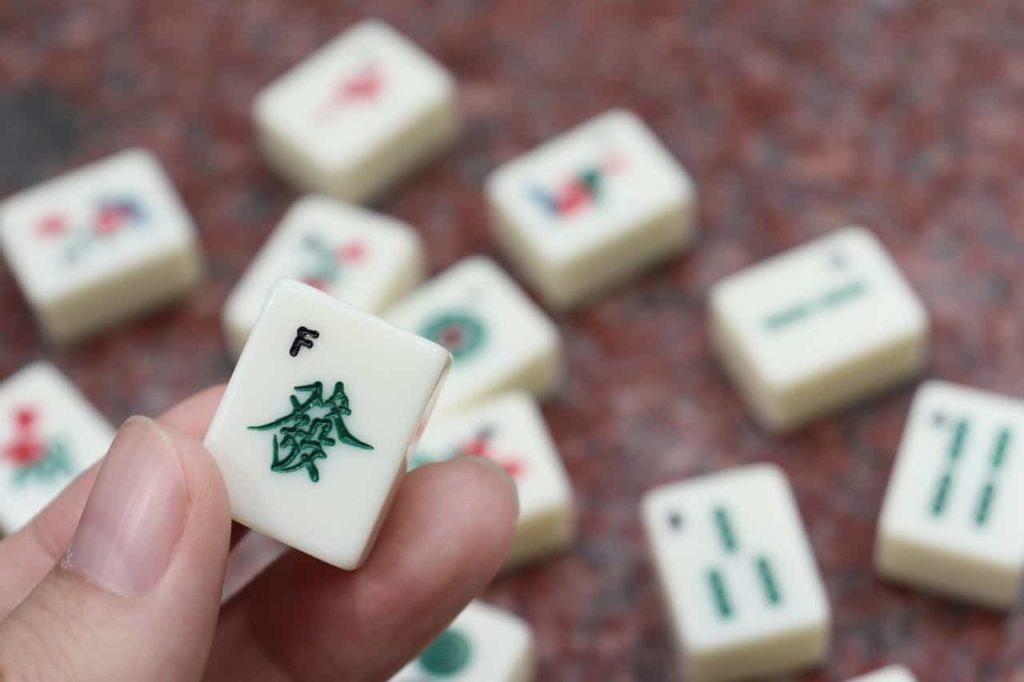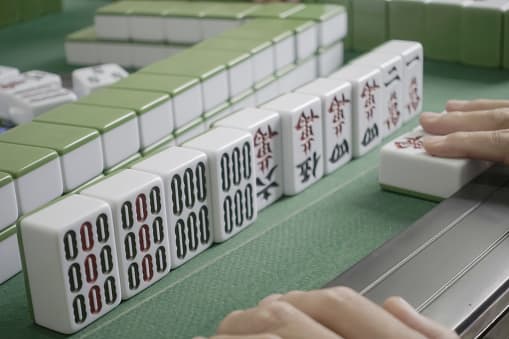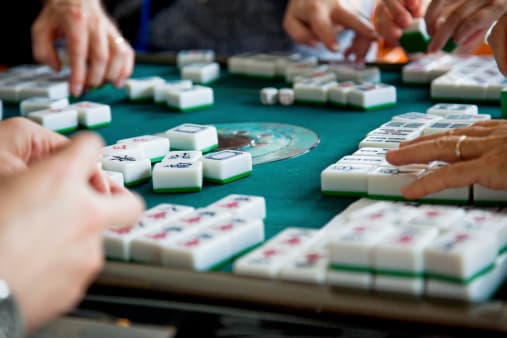The Ancient game of Strategy
Mahjong is an ancient Chinese game that has been played for centuries. It is a tile-based game that requires strategy, skill, and a bit of luck to win.
The game has evolved over time with different variations and adaptations across the globe. In fact, Mahjong has become popular worldwide, especially in America where it has taken on a unique and distinct form known as American Mahjong.
A Brief History of Mahjong in America
Mahjong arrived in America in the early 20th century through Chinese immigrants who brought it with them to share with their communities. At first, it was primarily played within Chinese communities but eventually spread to non-Chinese players as well. By the 1920s, Mahjong had become extremely popular among women in America.
This led to a surge in production and sales of American-made sets tailored specifically for western play styles. Over time, several variations emerged from different regions across America resulting in unique versions such as Western/Joker-style mahjong or American mahjong (with its own set of rules).
The Basics of American Mahjong
Tiles and Equipment
American Mahjong is played with a set of 144 tiles, which are similar to those used in the Chinese version of the game. The tiles are divided into different suits: dots/circles, bamboo/sticks, and characters/numbers.
Each suit has tiles numbered from one to nine and there are four tiles for each number. In addition to these suits, there are also honor tiles (winds and dragons) which have special significance in the
To play American Mahjong, you will need a set of Mahjong tiles and a table around which players can sit. Many sets come with accessories such as racks for holding your tiles, scorecards for tracking points during the game, and betting chips if you wish to add an element of gambling to your gameplay.
Objective and Gameplay
The objective of American Mahjong is to be the first player to complete a winning hand by creating sets or runs using your tiles. A set is made up of three or four matching tiles while a run is made up of three consecutive numbers from the same suit.
To win, you must have at least one pair (two identical tiles) in your hand along with any combination of sets or runs that meet the requirements for a winning hand. Gameplay begins with all players building their walls out of their respective tile sets.
Then each player takes turns rolling dice to determine who goes first and how many spaces their wall will move during play (this determines where other players draw their replacement tile from). Play then proceeds around the table clockwise as each player takes turns drawing a tile from the wall and discarding one until someone completes a winning hand.
Scoring and Winning Hands
There are many possible winning hands in American Mahjong, each with different point values based on difficulty level. Some popular winning hands include “The Big Four” which require a player to collect one of each of the four wind tiles, and “The Little Four Winds” which requires a player to have three out of the four winds in their hand along with a pair.
Other winning hands might be based on the number of different types of sets or runs in your hand. Scoring is done based on the value of each tile in your hand along with any bonus points for completing certain objectives (such as collecting all four winds or dragons).
The winner receives points from each losing player while losers pay out to the winner. Points can be tallied throughout several rounds or games until an agreed-upon amount is reached for a final winner.
Strategy and Tactics in American Mahjong
Identifying Patterns and Sequences: The Key to Success
In American Mahjong, identifying patterns and sequences is the essential step in developing a winning strategy. The game is all about creating sets of tiles that follow specific rules, so understanding these rules is the key to success. There are several types of sets that you need to create in order to win the game: Pungs (three identical tiles), Kongs (four identical tiles), Chows (three consecutive tiles in the same suit) and pairs.
The first step in identifying patterns is to look for pairs – two identical tiles. Once you have identified a pair, you can start looking for other tiles that will help you create sets of three or four.
For example, if you have a pair of dragons, you should look for another dragon tile to complete a pung set. Another important pattern is the consecutive sequence (Chow).
If you see two or more sequential numbers on your rack, it may be worth keeping them because they could be part of an eventual Chow set. Remember that Chow sets can only be made from one suit; so if your hand contains more than one suit with consecutive numbers, it may be difficult or impossible to complete a Chow set.
Understanding Tile Values: Essential Knowledge for Winning
To develop an effective strategy and increase your chances of winning at American Mahjong, it’s important to understand the values of each tile on your rack. Tiles are divided into three types based on their face value: simple suits, honor tiles and bonus tiles. Simple suits are numbered 1-9 and are divided into three groups: dots/circles (balls), bamboo/sticks/jade (sticks) and characters/numbers/wan (bams).
Honor Tiles include Dragon Tiles – Red Dragon/Green Dragon/White Dragon – and Winds – East/West/North/South. Bonus tiles include Flowers and Seasons.
Knowing the values of each type of tile is essential to developing a winning strategy. For example, the honor tiles are worth more points than simple suits, so it may be wise to try to create sets with honor tiles when you can.
Developing a Winning Strategy: Tips and Tricks
Creating sets is one way to win at American Mahjong, but there are other strategies that can improve your chances of success. One effective strategy is playing defensively and discarding tiles that opponents might need to complete their own sets. Another strategy is to bluff by discarding tiles that you don’t need, in the hopes of confusing your opponents.
It’s also important to pay attention to the other players’ discards because they may give you clues as to which sets they’re trying to complete. Additionally, keeping track of which tiles have already been played can help guide your strategy and prevent others from creating sets before you.
Overall, developing a winning strategy in American Mahjong requires patience, discipline and knowledge of patterns, tile values and effective tactics. With practice and dedication, you’ll be well on your way to becoming a master of this fascinating game!
Advanced Techniques in American Mahjong
Reading the Wall: Predicting Tiles With Accuracy
Reading the wall is an advanced technique that can help players predict which tiles are more likely to be drawn next. The wall refers to the tiles that have not yet been drawn from the stack. By paying close attention to which tiles have already been played and which ones are still in the wall, a player can improve their chances of completing certain hands.
One way to read the wall is by looking for patterns or sequences that have already been played. For example, if there have already been several pairs of dragons played, it’s less likely that another pair of dragons will be drawn soon.
Instead, a player might focus on collecting tiles for a different set or sequence. Another important factor in reading the wall is understanding which tiles are still available.
As more tiles are played, it becomes easier to determine which ones are still in the wall and therefore more likely to be drawn next. By keeping track of which tiles have been discarded and calculating how many remain in the wall, players can make more informed decisions about their strategy.
Playing Defense: Blocking Your Opponents' Hands
Playing defense is an essential aspect of successful mahjong play. In addition to working on their own hand, players must also pay close attention to their opponents’ hands and prevent them from completing winning sets or sequences.
One effective defensive technique is blocking. This involves discarding tiles that would complete an opponent’s set or sequence, even if those tiles could be used for one’s own hand.
For example, if an opponent had two dots and was trying to complete a set of three dots, a player might discard another dot tile in order to prevent them from winning with that set. Another defensive strategy is called fishing for honors or terminals.
This involves discarding non-honor and non-terminal tiles in order to bait opponents into discarding the tiles needed to complete their winning hand. By paying attention to which tiles an opponent has already played and which ones they are likely to need, a player can increase their chances of blocking their opponent’s hand.
Bluffing and Deception: Misleading Your Opponents
Bluffing and deception are advanced techniques that involve intentionally misleading opponents about the state of one’s own hand. This can be done by discarding tiles that suggest a different type of set or sequence than what a player is actually working on, or by intentionally keeping certain tiles hidden from view. One way to bluff is by discarding “safe” tiles early on in the game, in order to make it seem like one is not working on a specific set or sequence.
If an opponent assumes that a player doesn’t need those tiles, they may discard them themselves, allowing the player to pick them up later. Another deception technique is called “hiding” your hand.
This involves concealing certain tiles from view so that opponents cannot accurately predict what sets or sequences you are working on. By keeping some information hidden, players can gain an advantage over opponents who are relying solely on visual cues.
These advanced techniques in American Mahjong require a mix of strategy and skillful observation. Reading the wall takes careful attention and practice to master but it is essential towards improving gameplay accuracy.
Playing defense using blocking techniques prevents opponents from completing winning sets while baiting them into discarding other non-terminal tiles increases your chances at winning through bluffs/deceptions when done correctly. Perfecting these skills will take time but will greatly improve your overall gameplay precision while making you harder for your opponents to read!
Variations on Amiercan Mahjong
In addition to the standard rules of American Mahjong, there are several variations that players can try out to add some variety and challenge to their gameplay. Here are three popular variations that you might encounter:
Charleston Variation: Adding a Level of Strategy
The Charleston is a traditional component of American Mahjong play that adds a level of strategy and complexity to the game. In this variation, players pass three tiles to their left or right before beginning each round. The passing can be done in one of two ways: players can either pass three tiles at once (known as a “group”) or they can pass one tile at a time (known as “singles”).
The goal of the Charleston is to allow players to improve their hands by discarding tiles that are not useful while receiving new ones that may be more valuable. However, since players must do this blindly without knowing what tiles they will receive in return, it also requires careful planning and consideration.
Jokerless Variation: A More Challenging Version
The Jokerless variation is exactly what it sounds like – it eliminates the use of Jokers from gameplay entirely. This makes the game more challenging since Jokers are often used as wild cards that can stand in for any other tile.
Without Jokers, players must rely solely on the tiles they draw from the wall and must be more strategic about which sets they choose to pursue. It also means that certain winning hands (like Seven Pairs) become impossible.
Wright Patterson Rules: An Uncommon Twist
Wright-Patterson Rules is an uncommon variation on American Mahjong that originated with members of the Wright-Patterson Air Force Base community in Ohio. In this version, additional sets are added to gameplay in order to make it easier for beginners to score points. Players can form “chows,” or sets of three tiles in sequence, from any suit (not just their own) and there are additional scoring opportunities for certain hands like the “Wright-Patterson Special” (consisting of two pungs, a chow, and a pair) and the “Peters-Buschman Special” (consisting of two concealed pungs, a kong, and any pair).
Overall, these variations on American Mahjong offer players an opportunity to mix up their gameplay and try out new strategies. Whether you’re looking for more challenge or just something different, incorporating one of these variations into your next round of play could be just what you need to keep things exciting.
Tips for Playing American Mahjong Online
Choosing a Platform to Play On
When it comes to playing American Mahjong online, there are a variety of platforms to choose from. Some popular options include Mahjong Time, Real Mah Jongg, and the National Mah Jongg League.
Each platform has its own unique features and benefits, so it’s important to do your research before choosing one. Consider factors such as the user interface, game options, player community, and cost when making your decision.
You may also want to check if the platform offers tutorials or practice games for beginners. Reading reviews from other players can also be helpful in determining which platform is the best fit for you.
Etiquette for Online Play
Just like in-person games of Mahjong, online play requires players to adhere to certain etiquette guidelines. These include being respectful towards other players, refraining from cheating or manipulating the game, and avoiding unsportsmanlike behavior.
In addition to these general guidelines, there are some specific rules that apply specifically to online play. For example, you should avoid interrupting gameplay with unnecessary chat messages.
It’s also important not to reveal any private information about yourself or others while playing online. Remember that while playing American Mahjong online can be a fun way to connect with others who share your love of the game, it is still important to maintain a level of professionalism and respect towards your fellow players.
Troubleshooting Technical Issues
As with any online activity, technical issues can sometimes arise while playing American Mahjong. If you encounter problems with lagging gameplay or glitches in the software, there are several steps you can take to troubleshoot these issues. Firstly, make sure that your internet connection is stable and strong enough for smooth gameplay.
You may also want to try clearing your browser cache or restarting your computer to see if this resolves the issue. If the problem persists, you may need to contact technical support for the platform you are using.
Many platforms offer customer service options such as email or chat support, so don’t hesitate to reach out if you need assistance. By taking these steps to troubleshoot technical issues, you can ensure that your online American Mahjong experience is as enjoyable and seamless as possible. Resources for Learning More About American Mahjong
American Mahjong is a complex and constantly evolving game that requires dedication and practice to master. Fortunately, there are many resources available for those who want to learn more about the game. Here are some of the best resources for learning more about American Mahjong. Books on the Subject
One of the best ways to learn more about American Mahjong is by reading books on the subject. There are many great books available that cover everything from the basics of gameplay to advanced strategies and tactics.
Some of the most popular books on American Mahjong include “The Red Dragon & The West Wind” by Tom Sloper, “Mah Jongg: The Art of the Game” by Ann Israel and Gregg Swain, and “Winning American Mah Jongg Strategies: A Guide for Beginner and Intermediate Players” by Elaine Sandberg. These books provide a wealth of knowledge about all aspects of American Mahjong, including tile values, scoring systems, and winning hands.
They also offer insights into advanced techniques like bluffing and deception, as well as tips for playing in tournaments and competitions. Whether you’re a beginner or an experienced player, these books are an excellent resource for learning more about American Mahjong. Online Communities and Forums
Another great resource for learning more about American Mahjong is online communities and forums. These websites offer a platform where players can share information, discuss strategies, ask questions, and connect with other players from around the world.
Some popular online communities include mahjconnect.com, mahjongsafari.com, mymahj.com. Online communities offer several benefits over traditional learning methods like reading books or attending classes.
They allow players to interact with other players in real-time which can help them develop their skills faster than self-study alone would allow. Additionally they may provide access to experts that can answer questions or provide guidance on a particular aspect of the game. Tournaments and Competitions
Participating in tournaments and competitions is an excellent way to learn more about American Mahjong. These events bring together players from around the world to compete for prizes and bragging rights.
They offer players a chance to test their skills against top-level competition, as well as an opportunity to meet other players who share their love of the game. There are many different types of tournaments and competitions available for American Mahjong players.
Some are single-elimination events, while others involve multiple rounds or even entire seasons of play. Some popular tournaments include The National Mah Jongg League’s Tournament in New York City, The World Series of Mahjong in Macau, and The Las Vegas Open Mah Jongg Tournament.
Attending these events can be a great way to learn more about American Mahjong and meet other players who share your passion for the game. Whether you’re a beginner or an experienced player, there is always something new to learn about American Mahjong at a tournament or competition.
Conclusion
Encouragement to Try Playing American Mahjong
We highly encourage you to give American Mahjong a try! Not only is it fun and challenging but it’s also a great way to socialize with friends or meet new people. The game is enjoyed by people of all ages from around the world making it an excellent way to connect across cultures.
By learning how to play American Mahjong, you will also be investing in your mental health. Studies show that engaging in activities that require focus and strategy can help improve memory function as well as reduce stress levels.
Final Thoughts on the Game's Cultural Impact
American Mahjong has not only proven itself as a popular game throughout America but has played an important role in shaping cultural relations between countries across the world. The game has brought people together across language barriers and cultural differences through its shared love for strategy games.
Furthermore, learning about other cultures through games like Mahjong can help promote empathy while simultaneously reducing negative stereotypes associated with different ethnic groups. As such, we hope that this guide encourages more people to try their hand at this timeless classic game for both personal enjoyment and broader societal benefits.





